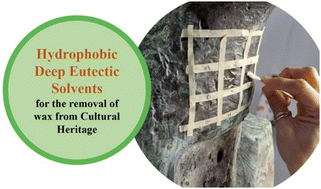Sustainable solutions for removing aged wax-based coatings from cultural heritage: exploiting hydrophobic deep eutectic solvents (DESs)
Abstract
This study describes the investigation on the use of hydrophobic Deep Eutectic Solvents (DESs) for the removal of nonpolar coatings from works of art to replace toxic solvents. Beeswax and two microcrystalline waxes (R21 and Renaissance®) have been selected as reference nonpolar coatings since they are commonly present in their aged state on metal and stone artifacts. The interaction between the DESs and three waxes has been evaluated through contact angle measurements, solubility tests, and cleaning tests carried out by implementing a method that is ordinarily used by restorers. Tests have been conducted on mockups consisting of microscope glass slides covered by wax. The effective removal of the wax-based coating from the mockups has been assessed through spectrocolorimetry and multispectral imaging under visible (VIS) and ultraviolet light (UV) at 365 nm by loading the waxes with a fluorescent marker (Rhodamine 6G). Fourier Transform Infrared (FT-IR) spectroscopy in the Attenuated Total Reflectance (ATR) mode was performed to assess the presence of both the wax and the solvent on the swabs used for the cleaning tests, confirming the actual interaction among the solvent and the solute. The experimental process proved DESs’ potential of being used as green solvents for cleaning treatments on Cultural Heritage.



 Please wait while we load your content...
Please wait while we load your content...